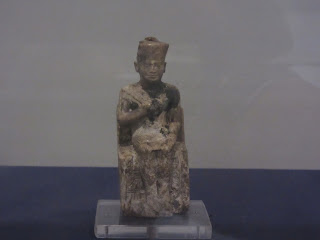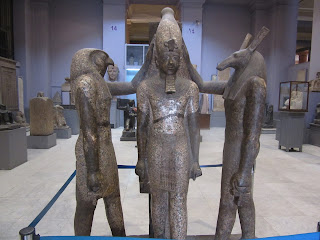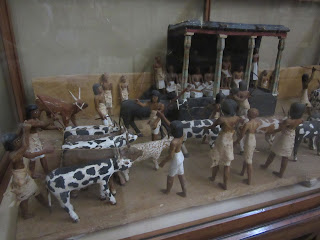It was only about a 15 minute walk from our hostel past the infamous Tahrir Square, the location of the beginning of the Arab Spring, to the Egyptian Museum. It has one of the world's most important collections of ancient Egyptian artifacts and Steven and I planned to spend several hours there. One of the most famous bakeries in all of Cairo was just a block from the hostel and on the way to the museum so we popped in to fortify ourselves first!
Just one small part of the immense Midan Tahrir or Tahrir Square:
However, to enter the area where there was also a large hotel in addition to the museum, we had to go through a police checkpoint. There was a chain across the entrance and I noticed bomb-sniffing dogs were employed and vehicles were searched as they entered.
It is said that if you were to look at every piece for one minute it would take you nine months to see it all - that sounded absolutely overwhelming so we were only going to concentrate on the highlights based on recommendations from a travel guide.
Until 1996, museum security involved locking the door at night. When an enterprising thief stowed away overnight and helped himself to treasures, the museum authorities installed alarms and detectors. During the 2011 revolution, the museum was broken into and a few artifacts went missing. To prevent further looting, activists formed a human chain around the building to guard its contents. By most reports, they were successful.
The ground floor of the museum was roughly laid out in chronological order so we began looking at sculptures and artifacts from the Old Kingdom first, the period from 2532 -2503 BC.
The black schist triads depict the pharaoh Menkaure, the builder of the smallest of the three pyramids. The king was wearing the tall white crown of Upper Egypt. The figure to the pharaoh’s right is the sky goddess Hathor and the divine mother of the king. She was the goddess that I mentioned in the post on Giza we had hoped to see. On Menkaure's left is the Nome goddess who, in the inscription, promised to give the king 'all the good things that come from Upper Egypt.'
Funeral chamber of painted limestone discovered at Sakkara, one of trhe places we visited in our tour around Giza a couple of days ago.
This was titled ‘The Egyptian Pikemen’ and was from the Middle Kingdom's 11th dynasty. The tag said that the 40 wooden soldiers in ten lines were found in a tomb, they each wore kilts to facilitate movement and their shields were made of cow hide. This piece was designated the Museum's Object of the Month for October.
One of the masterpieces of the Old Kingdom was the stunning wooden statue of Ka-Aper, discovered at Sakkara in 1870. It was carved out of a single piece of sycamore though the legs were modern restorations. The sycamore was sacred to the goddess Hathor. Ka-Aper’s large belly suggests his prosperity.
His eyes were amazingly lifelike: set in copper lids with the whites made of opaque quartz and the corneas from rock crystal, drilled and filled with black paste to form the pupils.
One of the museum’s masterpieces is this smooth, black statue of Khafre. The builder of the second pyramid at Giza sat on a lion throne and was protected by the wings of the falcon god Horus. Khafre had 23 identical pieces carved for his valley temple but this is the only one that survived.
It was amazing we could get right up to so many of the displays and sculptures with no cords or barriers in between. This piece that also came from Sakkara was called ‘Man Preparing Beer Jars.’ I don't think it was one of the museum's highlights but I couldn't resist taking the photo and writing down the caption!
'Old Kingdom Heads, probably intended to represent prisoners,' made from gray granite, alabaster and diorite.
One room was dominated by the beautiful statues of Rahotep and Nofret, a noble couple from the 4th dynasty. Almost life-size with well preserved painted surfaces, the limestone sculptures had very simple lines that made them seem almost contemporary, even though they have been around for an astounding 4,600 years!
Wooden Statue of Mitri from the 5th to the 6th Dynasty: one of 11 that were found. Wood was a rare and expensice material in ancient Egypt so this statue reflected his high rank and power. He is shown in the classic scribal position with a papyrus roll in his lap and a writing implement in his hand.
In a nearby cabinet there was a limestone group of Seneb, ‘chief of the royal wardrobe,’ and his family. Seneb is notable for being a little person; he sits cross legged with his two children strategically placed to cover his short legs. His full-size wife, places her arms protectively around his shoulders. Rediscovered in their tomb in Giza in 1926, the happy couple and their two children were more recently used in an Egyptian family-planning campaign!
The museum entrance price was pretty hefty and we were surprised at how rudimentary the museum was in many ways: it was very dusty, dirty in many areas and there was no AC which made for a hot few hours. Considering its monumental collection of antiquities, we had expected more.
Many of the smaller items were in the same glass cabinets they were placed in when the museum opened in 1902. The lighting was so poor in some halls that we needed to squint to make out details and read the words on the typed display cards placed on a few key items.
A panel of the Meidum Geese: It was part of an extraordinarily beautiful wall painting from a mud-brick bench above a tomb at Meidum. Though painted around 2500 BC, its pigments still remained vivid and the degree of realism has made it possible for ornithologists to identify the species with no trouble. I overheard a guide say that four types of the geese in the picture are still in existence today.
Seeing that painting brought tears to my eyes as here is a photo of the same drawing we have at home. It was painted by my maternal Great Aunt Nina de Garis Davis about 100 years ago when she and her husband, Norman, worked in the early and mid-twentieth century drawing and documenting tomb paintings in Egypt. Nina spent half of her time making drawings for the Metropolitan Museum in New York where we have seen many of her other paintings. I saw a pretty long wikipedia article and other articles written about her contributions to the field of Egyptology.
My mother inherited Nina's home in Bedford, England, when she died in 1965. Twenty years later, Steven and I named our first born daughter after her. Nina: I hope you too will be able to visit Egypt one day and discover the land where your namesake spent so much of her life.
I was particularly interested in the King Cheops statue found in Abydos in southern Egypt because we would be going there in a few days on one of our day trips from Luxor. The miniature ivory statue is the only surviving representation of the builder of Egypt’s Great Pyramid. When the statuette was excavated, three weeks elapsed between the discovery of the head and body.
The Statue of Montuhotep: He was the first ruler of the Middle Kingdom period (2055-2004 BC). He is shown with black skin which represented fertility and rebirth and wearing the red crown of Lower Egypt. It was discovered in 1900 when the ground gave way under the horse of the famous English archeologist Howard Carter!
I was amazed at the filth and the almost total absence of guards. It was mind boggling to me that we didn’t see them walking around telling people to keep their hands off the priceless pieces of art.
A life-size pink granite statue of Hatsheput who was co-regent for part of Tutmosis III’s reign and eventually had herself crowned as pharaoh. Although she wears a pharaoh’s headdress and a false beard, the statue still had feminine characteristics.
The sign said No Touching but it was not enforced and was sadly disregarded.
Colossus of Akhematen or Nefertiti: According to the caption, this statue has given rise to a lot of controversy. The royal body, which is either naked or clothed with a tight fitting garment is clearly not male. Early scholars thought it depicted Akhematen as a god and represents the hermaphroditic nature of Aten, 'the father and mother of all.' However, a current interpretation is that it is of Nefertiti, the goddess of moisture.
We saw the Tutankhamen Galleries next. The treasures of the young New Kingdom pharaoh, who ruled for only nine years during the 14th century BC, are among the world's most famous antiquities. There were about 1,700 of his items spread out on the museum's first floor!Akhenaten's coffin lid from the 18th dynasty: Some scholars believe that Tutankhamen succeeded Akhenaten on the throne and that he brought back his father's mummy in a woman's coffin when he returned to the old capital at Luxor.
One room contained Tutankhamen’s golden sarcophagus and jewels. His astonishing death mask has become an Egyptian icon. Made of solid gold and weighing 11 kilos, it covered the head of the mummy and lay inside a series of three sarcophagi. The mask was an idealized portrait of the young pharaoh. The eyes were made from obsidian and quartz while the outlines of the eyes and the eyebrows were delineated with lapis lazuli. No photos were allowed in that gallery and, unlike some places, the rule was strictly enforced. I was just aching to take a photo but had to content myself with one taken from outside the glass entrance.
The colossal statue of King Amenhotep IV showed the king in a traditional pose with arms crossed and holding two symbols of kingship, the crook and the flail. His odd, long face and sagging body were different from most kings. Nobody knows why he chose to be shown like that - perhaps to represent all of humanity as a male/female figure?
A triad in pink granite representing Horus, the falcon-headed, and Seth, the jackal-headed, crowning Ramses IIIThree beautifully preserved statues from the 26th-27th dynasties found in Psametik's tomb at Sakkara:
The limestone statue of Zoser aka Djoser (2667-2648 BC), whose chief architect, Imhotep, designed the revolutionary Step Pyramid at Sakkara, was the first one found with a moustache. This was the oldest statue of its kind in the museum. The seated, near life-size figure has lost its original eyes but was still very impressive in a tight robe and striped head cloth over a huge wig.
A sense of how huge and overwhelming so much of the museum was as priceless items were crammed into every inch of space.
The double-sided Narner Palette found near Edfu – another one of the places we’d be visiting on a day trip from Luxor in a few days – was of great significance. Dating from around the 1st dynasty, it depicts Pharaoh Narner, circa 3100 BC, wearing on one side, the crown of Upper Egypt and, on the other side, the crown of Lower Egypt, suggesting the first union of both regions under one ruler. Egyptologists take this as the birth of ancient Egyptian civilization and Narner’s reign as the first of the first dynasty. This was the starting point for more than 3,000 years of Pharaonic history in which more than 170 rulers presided over 30 dynasties and produced almost everything in the Museum.The Clay Head from the 4th millennium BC, was one of the earliest human representations found in Egypt.
In this fabulous large gray-granite representation of Ramses II (1279-1213 BC), builder of the Ramseseum – something we’ll be seeing in a few days – he was depicted as a child with his finger in his mouth nestled against the breast of a great falcon, the god Horus. (You’ll be seeing lots more of Horus in the Luxor posts.)
Funeral procession from the Middle Kingdom excavated in Sakkara:
Mummies Halls: These rooms housed the remains of some of Egypt’s most illustrious pharaoh’s and queens from the 17th to the 21st centuries, 1650 to 945 BC. They lay in individual glass cases kept in two temperature-controlled rooms on either side of the museum. The mood inside each of the rooms was suitably somber and talking above a whisper was forbidden. It was interesting to read that displaying dead royalty has been controversial. Late President Anwar Sadat took the royal mummies off display in 1979 for political reasons. However, the subsequent reappearance of 11 of the better-looking mummies did wonders for tourism figures in 1994. That inspired the opening of a second mummy room with lesser known figures.
King Amnehotep I died in his late 40s during the 18th dynasty, circa 1525-1505 BC. The body was later rewrapped by 21st dynasty priests and provided with a new mask and a garland of flowers.
Tuthmosis II lay next to his wife Hatsheput, the great queen and female pharaoh died at the age of 45 and was the tallest New Kingdom pharaoh at 1.83 meters tall. He was found in his own sarcophagus. His body was shipped up and down the Nile and stolen from his tomb in the Valley of the Kings so it was good to see him finally at rest!
The body of King Ramses II was strikingly well preserved: his gray hair was tinged with henna and we could even notice his long fingernails still!
King Ramses IV’s body: His eyes were replaced by small onions, his skull was filled with resin and his abdomen was filled with lichen!
Animal Mummies & Animals in Ancient Egypt: Animal cults grew in strength throughout ancient Egypt as the mummified cats, dogs, crocodiles, birds, monkeys and jackals suggest. Tucked in a dim, dusty wing of the museum, their rigid forms
were a bit creepier than their human counterparts. Some edible beasts became
‘victual mummies,’ preserved as food and ‘browned’ with resin to offer the
pharaoh an eternal picnic. Lucky pharaohs!
This dog was probably used as a hunting dog. It is unknown which king may have used the dog.
The Sacred Ram with a wooden crown; it was completely eviscerated and the body cavity was filled with linen. The condition of the skeleton indicated it died when it was very old.
After seeing these Votive Mummifications, we figured we'd seen enough mummies to do us for a good, long while!
Model Nubian Armies: We had just seen the companion piece shortly after we entered the museum. Dating from the 11th dynasty, about 2000 BC, the set of 40 wooden warriors marched in phalanxes.
These darker soldiers were Nubian archers from the south of the kingdom each wearing brightly colored kilts of varying design. The lighter-skinned soldiers we had initially seen were Egyptian pikemen.
The next series of exhibits we saw were called Portrait of daily life. These lifelike models were mostly found in the tomb of Meketre, an 11th dynasty chancellor in Thebes. I read that, like some of the best Egyptian paintings, they provide a fascinating portrait of daily life almost 4,000 years ago.
There were lots of displays portraying ancient Egyptians as seafarers. These boats were from the Middle Kingdom.
Canopic jars: They were used to store the extracted internal organs in after the body was mummified!
One scene made of painted wood and linen, showed Meketre, circa 2050 BC, sitting with his son, four scribes and servants around them in a kiosk, counting cattle.
The guards are not only watching Merketre but also the records of the cattle. The chief herdsman stands before Merketre presenting the number of animals as they pass. The detail of each figure and animal was absolutely amazing. Steven said it looked exactly like parents said they needed toys made for their children. Some more canopic jars:
We saw a number of blue faience objects.
The Ancient Egyptian Jewelry Gallery: Even after Tutankhamen’s treasures, the dazzling collection of royal jewelry took my breath away.
Do you think these gold earring were heavy enough?!
An alabaster chest:
As we left the museum, we saw the tomb of Auguste Mariette, the French archeologist who was responsible for creating the Egyptian Antiquities Service in 1858. Interestingly, he was also busy shipping his finds home from Sakkara to the Louvre!
No matter how many pictures we had seen of these treasures, nothing could prepare us for the reality of seeing them. As a travel writer said, walking through the Egyptian Museum was like embarking on an adventure through time.
Posted from Al Wasil, Oman on November 6th, 2016.


























































































Annie, nice pic of you and the "goose picture." I'm glad you saw the original. I'll be in Oxford in a few months and do wish we still had Great-Aunt Nina's property, which I have vivid memories of visiting. Hugs from Austria!
ReplyDeleteJust wow!
ReplyDeleteYour photos so much reminded me of my visit there about 10 years ago. Sometimes I think they need all the relics returned to them. But, they are better cared for in Europe. Yes, I remember the dust and heat. Lil Red
ReplyDelete